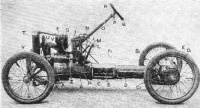Rover, the quintessentially British motor brand, was for decades celebrated for its classic designs that showcase the best in UK engineering. Its entry into the automotive world began in 1904, when it introduced its first car, the Rover 8. The 8hp vehicle, designed by Edmund Lewis, went on sale on 1 December and cost £200.

The Engineer’s archive reported on the trials of the vehicle at the Automobile Club in October. ’The engine is of the vertical single-cylinder water-cooled pattern with mechanically operated exhaust and inlet valves.
’The cylinder is 4 ½ inch diameter by 5 inch stroke, and it is claimed that 8 brake horse-power can be developed at a speed of 900 revolutions, while the engine is capable of acceleration up to 1,500 revolutions.’
The two-seater model had the first central backbone chassis in the world, as well as a novel pedal control that switched over the valve operating cams to provide extra braking. The tyres provided the only suspension at the rear of the vehicle.
“The car’s engine is capable of acceleration up to 1,500 revolutions”
’The gearing is designed to give three speeds forward and one reverse, namely 8, 16 and 24 miles per hour and 8 on the reverse,’ added The Engineer.
Founded in 1877 as a partnership between William Sutton and John Kemp Starley, Rover began as a cycle manufacturer, and had pioneered the modern safety bicycle. The Rover 8, however, proved so popular, that the company decided to change its business plan to manufacturing cars only.
Over the next few years, the Rover 8 model went through several modifications and became Britain’s best-selling car. It later paved the way for the £325 Rover Light Six, which earned fame when it became the first car to beat a train on the 750-mile trip from Calais to the French Riviera.




Poll: Should the UK’s railways be renationalised?
I think that a network inclusive of the vehicles on it would make sense. However it remains to be seen if there is any plan for it to be for the...